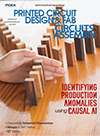News
News
Equipment Software Heating Up
Published: 02 March 2007
by Mike Buetow
Equipment and software advances ebb and flow. Machine makers push the limits of physics, then give way to the software guys who get (mostly) everything running in synch. Despite the aforementioned equipment introduction, I believe we are in the midst of a software renaissance. The reason: Lead-free has forced a renewed look at process optimization, and process optimization relies more on human knowledge than machine capability.
Perhaps that’s one reason SMT machine software sales are forecast to grow 35% between 2006 and 2013. According to research firm Frost & Sullivan, complete integration and ease of communication down the SMT line will lead to a market worth nearly $560 million. Said Frost senior research analyst Lavanya Ram Mohan, “As the demands for increased integration, communication, quality and factory level optimization rise, these markets are likely to accrue significant revenues in the future.”
OEMs are getting into the act. Siemens, for example, is spending $3.5 billion to acquire UGS, the maker of tools for collaborative product management, CAD, manufacturing and engineering (sold under the Tecnomatix brand, among others). And Agilent in January rolled out special defect prevention software, which incorporates component and paste measurements monitoring, SPC and charting capabilities into its AOI and SPI systems.
The risk here is that we go overboard with inline tools and lose focus on optimizing the process itself. As columnist Chrys Shea writes this month (page 67), “not only is a tweak a temporary fix, it masks a systemic problem.” Obviously, pure observation is too slow to accommodate all line changeovers. We need tools that collect – and make sense of – the important data. I am a fan of thermal profilers, for example, but admit that much of the data they compile is more for theoretical value until sophisticated trend analysis is applied. Profilers have become standard on reflow and wave machines, which is a good thing. But I would argue that what’s truly important in machine procurement and utilization is not obtaining the long list of on-board profilers, but rather making sure the one you buy is capable of quick, easy and – most of all – accurate process window development. In other words, they should add intelligence to the line, not just data collection.
And then the humans – the operators and engineers – should set up the processes accordingly, and let them be.
P.S. A new column debuts this month: Material Matters, by Dr. Renzhe Zhao. The catch: It's in Chinese. You can read the English version on our web site.
Also, congratulations to the winners of Circuits Assembly’s annual Service Excellence Awards. They include Key Electronics, Integrated Microelectronics Inc., Synchronized Manufacturing Technologies, MACK Technologies, Reptron, Asymtek, Assembléon, BPM Microsystems, DEK, BEST Inc., Kyzen, YESTech, EFD and Aegis Industrial Software. A donation of $5,000 was made on the participants’ behalf to the SMTA’s Charles Hutchins Educational Grant. For the full story, see page 12.
Press Releases
- SASinno Americas Welcomes Two Industry Veterans to Strengthen Sales and Technical Support Across the Americas
- ITW EAE Expands Production Capabilities for Centurion Reflow Ovens and Momentum II Printers
- Kyzen Promotes Erik Miller to Chief Operating Officer
- DOBOT Malaysia Opens to Accelerate Smart Manufacturing in Southeast Asia







